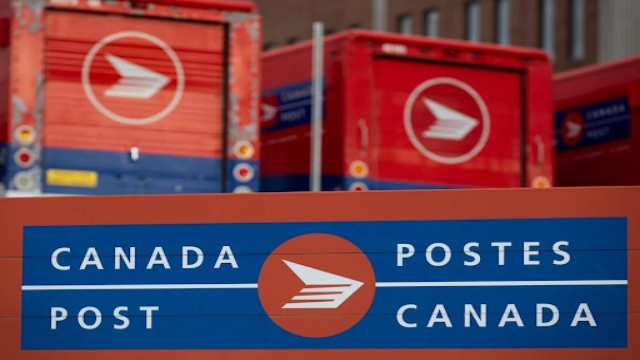
Canada Post signs and delivery trucks are visible outside a mail sorting centre in Ottawa. Photo credit: Spencer Colby / The Canadian Press
Canada Post has revealed it lost nearly $1.3 billion in 2024, marking its seventh straight year in the red. The Crown corporation, which delivers mail and parcels nationwide, has now accumulated $3.8 billion in losses since 2018. As financial pressure builds, Canada Post has tabled what it’s calling a “final offer” to the union representing its 55,000 workers, hoping to avoid another round of disruptive labour action.
Talks between Canada Post and the Canadian Union of Postal Workers (CUPW) resumed Wednesday. In an effort to break the deadlock, management offered a $1,000 signing bonus to urban workers and $500 to those in rural and suburban areas. The proposal also includes cost-of-living adjustments that would kick in earlier during inflation surges and a commitment to end mandatory overtime — a long-standing concern among staff.
However, one controversial element remains unchanged: a nearly 14% wage increase spread over four years and a plan to bring in part-time workers for weekend deliveries. This idea has drawn sharp criticism from full-time employees, who fear it could mean fewer weekday hours and a shrinking workforce.
Adding to tensions is Canada Post’s plan to roll out “dynamic routing” — a system where delivery routes would shift daily based on parcel demand — at 10 of its mail sorting facilities. While this could increase efficiency, many workers feel it would add unpredictability to an already demanding job.
The proposal echoes a federal report published earlier this month, which painted a grim picture of Canada Post’s future. The report bluntly stated that the organization is “effectively bankrupt” and must change to survive. It endorsed dynamic routing and the hiring of part-time staff with equal benefits as potential lifelines.
Last fall, a strike over similar contract issues shut down operations for a month and cost Canada Post $208 million. The chaos prompted customers and businesses to switch to private couriers, and some still haven’t come back. In fact, parcel deliveries fell by 20% last year, amounting to a $683 million drop in revenue. Canada Post says that overall parcel volume is down 65% compared to the same time last year.
To keep going, Canada Post received a $1 billion federal loan in January. But the long-term solution remains unclear.
Former letter carrier Lorraine Muller, now working at a sorting center in Montreal, believes workers are getting shortchanged and that the system needs a major overhaul. She suggests following the lead of countries like France or the Czech Republic, where postal services have added banking options to serve small communities abandoned by traditional banks.
“People trust us,” she said. “We’re not just here for paychecks. Let us serve our communities.”
Others in the industry worry about the impact on full-time staff. Labour expert Stephanie Ross warns that the rise of part-time roles could reduce hours for existing full-timers. Yet, she notes that permanent part-time positions with solid benefits could still be a step up from the current temporary gigs many workers are stuck in.
Meanwhile, businesses like Jet Worldwide say they’re better prepared this time around. After the 2023 strike, many e-commerce companies started exploring alternatives, unwilling to risk further disruption.
Canada Post is at a critical crossroads. Whether the new deal can prevent another breakdown — or whether it’s too late to win back the trust of workers and customers — remains to be seen.















